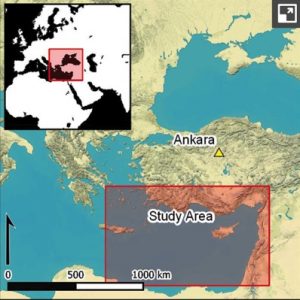Zooarchaeology, “is the systematic study of animal remains recovered from archaeological sites, with the goal of understanding past human life, in historic and prehistoric times” (University of Tennessee 2013). By looking at the fluctuation of animal species and numbers, archaeologists are able to identify how humans altered the environment, how they interacted with animals, or how their culture shifted over time. Turtles are one of the keystone species in the Mediterranean. Keystone species are a species that an ecosystem largely depends on. They are also a sensitive species to change, which makes them a good subject to study. By studying the fluctuation of turtle populations over time, archaeologists can attempt to discover not only how humans interacted with turtles but also how humans altered the environment that the turtles live in.
Around 10 years ago, Canan Cakirlar conducted a study of several different turtle species in the Mediterranean. Canan Cakirlar is the head of the zooarchaeology department at Groningen Institute of Archaeology. The study took place at five different sites that were previously fishing harbors and marine ports. These sites included Clazomenae, Kinet, Fadous, Beirut, and Burak in Lebanon. The study examined interactions between humans and turtles in the premodern past. There was no specific time period, rather it was a study of how premodern interactions led to the current population size of turtles in the areas (Cakirlar, Canan, Francis Koolstra, and Salima Ikram 2021).
The specimens collected were examined by context, what type of bone they were, weight, and any form of mark from butchery or gnawing. It was also determined whether the sea turtle was a Loggerhead, Green Sea Turtle, or a Nile soft shelled Turtle. The methods of calculating relative abundance utilized were %MNI (minimum number of individuals) and %NISP (number of identified individuals).
The study found that humans exploited turtles for their shells and meat. There was a sudden increase in the amount of turtle specimens found during the Iron Age, which is believed to be linked to increased access to metal tools and seafare. It is interesting to note that climate impacted the availability of turtles to humans in different places throughout time. The climate had an impact on nesting locations and availability of food. The weather can also affect the archaeology of human and turtle interactions. It is also a possibility that as new people moved into the Mediterranean they utilized the new animal to reduce food insecurity. Two of the more interesting finds were the decrease in size of bones which may have been due to domestication of turtles and that turtle specimens were almost nonexistent at the sites during the Upper Paleolithic and Epipalaeolithic periods.
Even though we know that humans had an impact on the turtle population in the Mediterranean throughout time, the overall significance of past human interactions on the present turtle population is not certain.
Obviously the exploitation of turtles for resources contributed to the diminished turtle populations now, but it cannot be said for certain it was all humans since the climate and state of nesting sites play important roles in the survival of turtles as well. More studies surrounding the speciesof turtles in the Mediterranean are being conducted in order to see the severity of impact on the turtle populations today.
References
Cakirlar, Canan, Francis Koolstra, and Salima Ikram
2021 Tracking turtles in the past: zooarchaeological evidence for human-turtle interactions in the ancient Eastern Mediterranean. Antiquity 95(379):125–141.
Casale, Paola
2007 A model of area fidelity, nomadism, and distribution patterns of loggerhead sea turtles (Caretta caretta) in the Mediterranean Sea. Heidelberg 152(5): 1039-1049.
Canan Cakirlar, Jort Bosman, and Salima Ikram
2019 Archaeozoology of the Near East XII. Barkhuis, Port Angeles
University of Tennessee
2013 Zooarchaeological Research. Department of Archaeology, Knoxville
Image References
https://www.nationalgeographic.com/animals/reptiles/facts/loggerhead-sea-turtle
Additional Content/Readings (Bibliography)
https://www.oceano.org/en/resources/which-sea-turtles-live-in-the-mediterranean/




